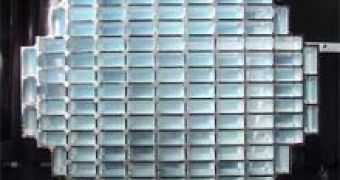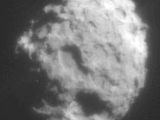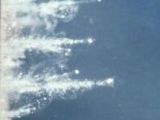NASA is celebrating the safe return to Earth of a pinch of dust harvested from a comet. On Sunday morning, after a seven-year journey, its Stardust spacecraft dropped a capsule containing comet dust into the Earth's atmosphere and it safely landed in the Utah desert in the US.
The Journey
The Stardust spacecraft was launched in February 1999, and reached a comet called Wild 2 in January 2004. Comet Wild 2 orbits the Sun between Mars and Jupiter. The spacecraft flew within 236 kilometers of the comet and extended a tennis-racket-shaped collector to trap dust particles in Aerogel, a transparent solid so light that it almost floats in air. Scientists think it captured more than 2000 particles wider than 15 micrometers. The mission's primary objective was the capture of these pristine particles from the comet. These were caught in the pores of lightweight glass foam. If the craft had been struck by a particle larger than one centimeter across, Newburn said, it would have blasted right through the Whipple shields and into the craft or its solar panels. Calculations had estimated there was about a one in 50 chance of this happening. "It was nervous time, without a doubt," Newburn said. Stardust also took photographs of Wild 2, which turned out to be a stunningly complex object. "I did not expect the comet would be very interesting, but it was absolutely awesome," says Don Brownlee of the University of Washington in Seattle, US, principal investigator for the mission. The observations revealed countless depressions with cliffs hundreds of meters high with overhangs, as well as bizarre tall pillars and pinnacles. The comet also had numerous active jets, where gas vents out at near-supersonic speeds. Dust and rocks were carried along with the gas, pelting Stardust with debris. "It was a bit like flying through anti-aircraft fire," says Brownlee. The dust was sealed inside a capsule for the return journey to Earth. On Sunday, at about 0600 GMT, the sample pod was released from the mothership. It entered the Earth's atmosphere just before 1000 GMT. At an altitude of about 32 kilometers, the capsule released a drogue parachute to stabilize its descent, and the main parachute opened at a height of about 3 kilometers. The capsule touched down gently in Utah at 1012 GMT (0312 local time). A fleet of helicopters arrived at the scene less than an hour later to retrieve the capsule and take it to a clean room in a nearby hangar. From there, it will move on to NASA's Johnson Space Center in Texas for analysis.
The data
With the sample safely back in the lab, scientists will be able to accurately measure the elements and isotopes in comets for the first time. Comet Wild 2 spent billions of years in the Kuiper belt, a frozen reservoir of icy bodies beyond Neptune. While heat and geological processes have altered the inner planets like Earth beyond recognition, comets like Wild 2 are thought to be fairly pure samples of the material that formed the solar system. Scientists will use state-of-the-art lab techniques to make precise measurements of the ingredients of the comet dust. This will give them window on the distant past, when the Solar System was forming 4.6 billion years ago. Chunks of the Stardust sample will soon be sent to labs around the world. A team in London, UK, hopes to begin work on it in February. "What's exciting is that we're near the front of the queue for a sample, so we'll get the first sniff of what these things are made of," says team member Phil Bland of Imperial College, London. Bland and his colleagues will study the minerals while they are still inside the Aerogel by shining X-rays onto them. They hope to find out whether the mineral composition matches any rare classes of meteorites that might have come from comets. The composition of the dust could also shed light on whether comets delivered water to the Earth's surface. "We could get closer to finding out where the Earth's oceans and atmosphere came from," says Bland. "I was three years old when the last Apollo samples came back from the Moon," adds Bland. "So in my lifetime, this is the first time that geologists will have a chance to look at new material from space other than meteorites. We really can't wait."
The public help
Though Stardust's main mission was to capture dust from the tail of comet Wild 2, it also captured a sprinkling of dust from distant stars, perhaps created in supernova explosions less than 10 million years ago.
"These will be the very first contemporary interstellar dust grains ever brought back to Earth for study," said Andrew Westphal, a UC Berkeley senior fellow and associate director of the campus's Space Sciences Laboratory who developed the technique NASA will use to digitally scan the aerogel in which the interstellar dust grains are embedded. "Stardust is not only the first mission to return samples from a comet, it is the first sample return mission from the galaxy."
Based on previous measurements of interstellar dust by both the Ulysses and Galileo spacecrafts, Westphal expects to find approximately 45 grains of submicroscopic dust in the collector. Though those searching for pieces of Wild 2's tail will easily be able to pick out the thousands of cometary's dust grains embedded in the front of the detector, finding the 45 or so grains of interstellar dust stuck in the back of the detector won't be so easy.
Thanks to a grant from NASA and assistance from the Planetary Society, however, Westphal and his colleagues at the Space Sciences Laboratory have created a "virtual microscope" that will allow anyone with an Internet connection to scan some of the 1.5 million pictures of the aerogel for tracks left by speeding dust. Each picture will cover an area smaller than a grain of salt.
"Twenty or 30 years ago, we would have hired a small army of microscopists who would be hunched over microscopes focusing up and down through the aerogel looking for the tracks of these dust grains," said Westphal. "Instead, we developed an automated microscope to scan the aerogel and hope to use volunteers we have trained and tested to search for these tracks."
The Web-based virtual microscope will be made available to the public in mid-March, even before all the scans have been completed in a cleanroom at Houston's Johnson Space Center. In all, Westphal expects to need some 30,000 person hours to look through the scanned images at least four times. Searching each picture should take just a few seconds, but the close attention required as the viewer repeatedly focuses up and down through image after image will probably limit the number a person can scan in one sitting.
"It's amazing that Stardust flew without anyone having a clue as to how to get particles out of the aerogel after it came back," Westphal said. "You have to give NASA credit for taking a risk."
Once the grains are identified and analyzed, Westphal hopes the information will tell about the internal processes of distant stars such as supernovas, flaring red giants or neutron stars that produce interstellar dust and also generate the heavy elements like carbon, nitrogen and oxygen necessary for life.

 14 DAY TRIAL //
14 DAY TRIAL // 

